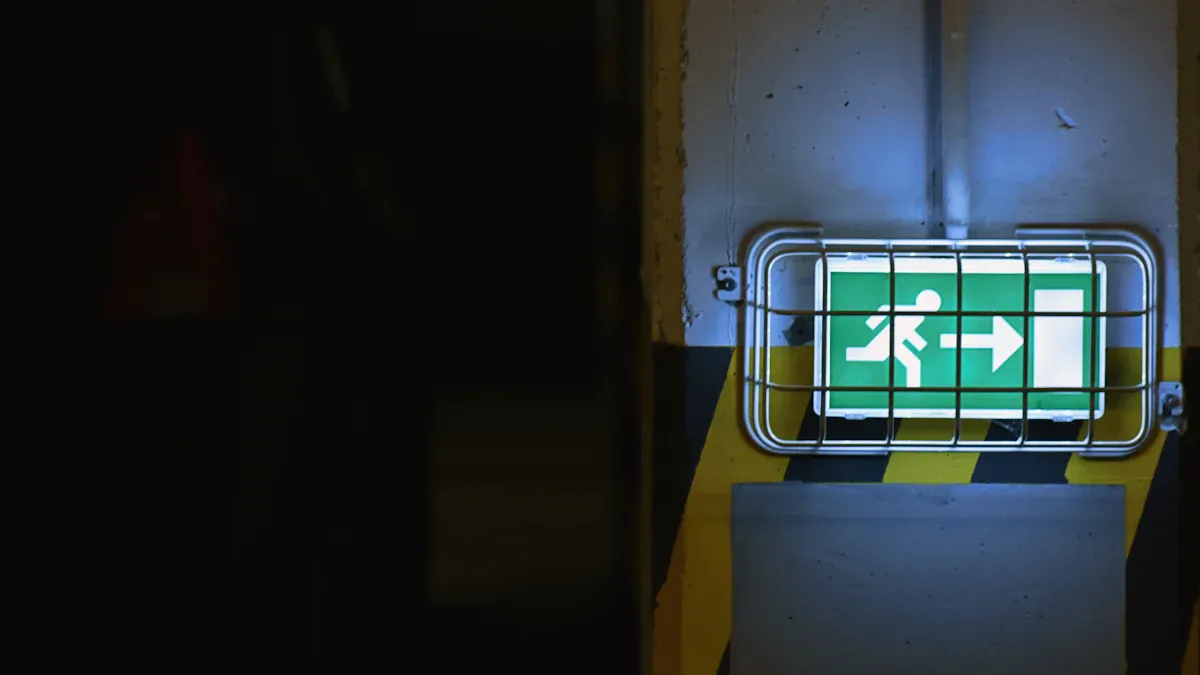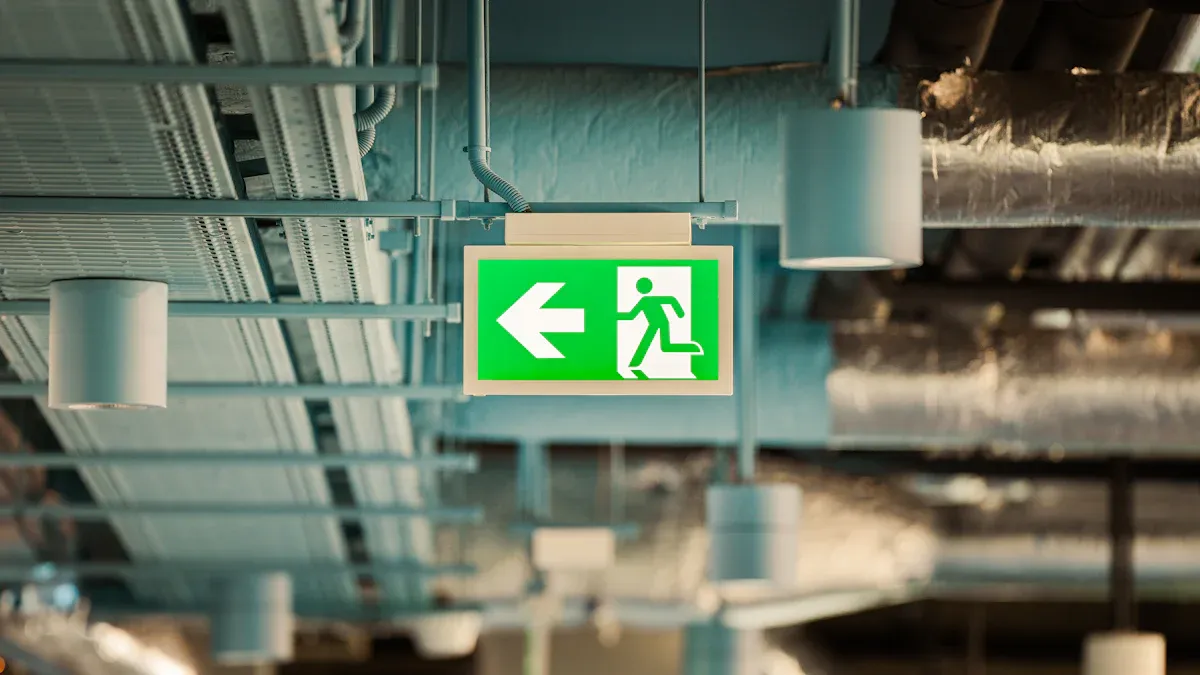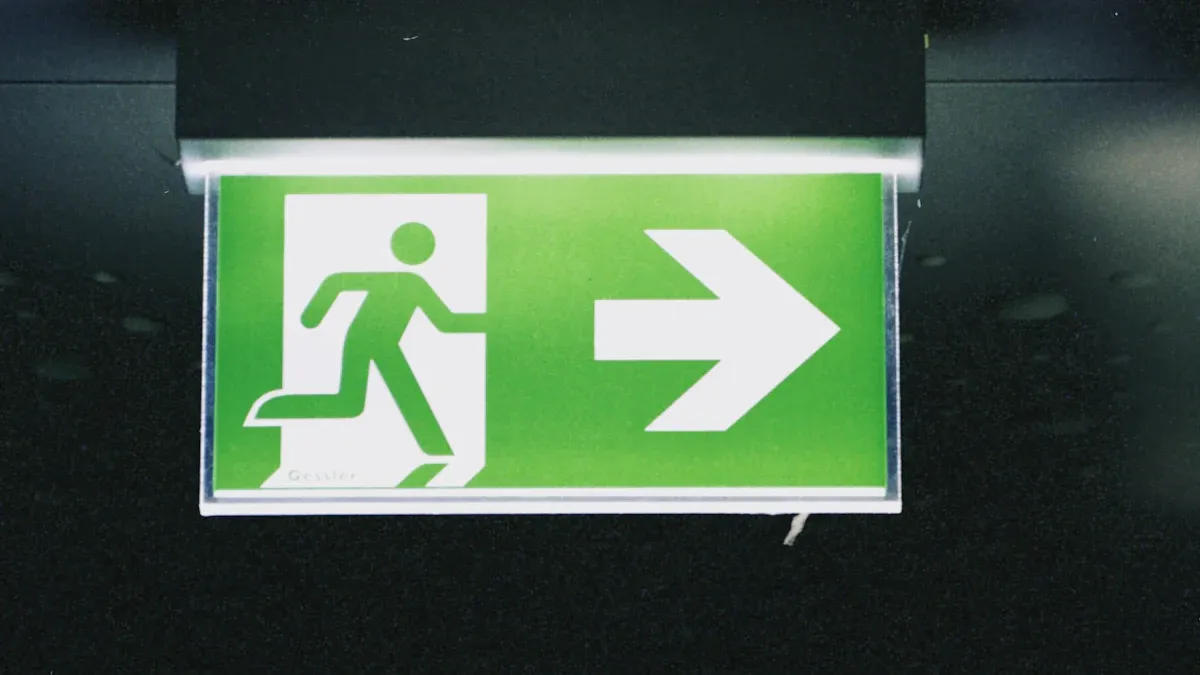Lighting Exit Pathways: Safety Requirements and Optimal Placement for Emergency Evacuation

Proper emergency lighting is crucial for safety at work during an Emergency Evacuation. Safety organizations emphasize that poor lighting can cause confusion, fear, and accidents. Without clear exit signs or adequate lighting, people may get lost, trip, or become trapped. Emergency lighting should illuminate all exit routes, including distant areas and corners where the path changes direction, to ensure safe evacuation. Facility managers must install lights in the right locations and select high-quality Led Light products. Bright exit lights not only help comply with safety regulations but also reduce risks and protect everyone during emergencies. To learn more, visit our About Us, Home, and Product pages.
Common risks of insufficient emergency lighting include:
Difficulty finding exits
Increased risk of falls
Getting lost in dark areas
Unsafe evacuation during emergencies
Key Takeaways
Emergency exit lighting should be bright and easy to see. Put lights in important places like hallways, stairs, and doors. This helps people find their way out if the power goes out.
Always follow safety rules from OSHA and NFPA. These rules say how bright lights should be and how backup power works. They also say signs must be easy to see. This helps keep people safe and avoids getting fined.
Test emergency lights every month to make sure they work. Once a year, do a full battery test for 90 minutes. This makes sure the lights will work when you need them.
Teach staff often about evacuation routes and emergency lighting. This helps everyone know what to do and keeps them safe.
Use new LED and smart lighting systems with remote checks. These help make things safer and make it easier to take care of the lights.
Safety Requirements
Illumination Standards
Emergency lighting is very important for safety at work. OSHA and NFPA have strict rules for how bright exit routes must be. These rules help people find exits in emergencies, even if the power goes out.
OSHA 29 CFR 1910.37(b)(6) says exit signs must be bright enough. They need at least 5 foot-candles (54 lux) or a luminance of 0.06 foot-lamberts (0.21 cd/m²).
OSHA 29 CFR 1910.37(b)(1) says exit routes must be lit well for normal vision.
NFPA 101 says emergency lighting must give at least 1 foot-candle (10.8 lux) at floor level.
The lowest light at any spot must not go below 0.1 foot-candle (1.1 lux) at first.
After 90 minutes, the average light can drop to 0.6 foot-candle (6.5 lux), but not below 0.06 foot-candle (0.65 lux) anywhere.
The brightest spot cannot be more than 40 times brighter than the darkest spot.
These rules make sure exit signs and lights are easy to see. Emergency escape lighting must work well, even in smoke or darkness.
A look at other countries shows U.S. rules are some of the strictest. The table below shows how they compare:
Parameter | U.S. Standard (NFPA/IBC) | Japan Standard | China Standard | CIE Recommendation |
|---|---|---|---|---|
Escape Route Illuminance | ~10 lux | 1-2 lux | 0.5 lux | 0.2 lux |
Emergency Lighting Duration | 90 minutes (typical) | Varies | Varies | Minimum 30 minutes |
Conversion Time to Emergency | Immediate automatic | Not unified | Not unified | Up to 15 seconds |

U.S. codes need brighter lights and longer run times than many places. This helps keep people safe in emergencies.
Duration and Power Sources
Emergency lights must work for at least 90 minutes if power fails. NFPA 101 says emergency and exit lights must stay on for 1.5 hours. This rule helps everyone use exits safely during a blackout.
Most emergency lights use batteries or generators. Approved batteries are sealed lead-acid, nickel-cadmium, and lithium iron phosphate. These batteries turn on emergency lights and exit signs when power is lost. Some exit signs use photoluminescent materials. These glow in the dark and do not need batteries. OSHA allows these as another option.
Battery backup lights use their own batteries for at least 90 minutes.
Some units combine exit signs and emergency lights and meet UL 924 standards.
Lighting inverters change DC battery power to AC for emergency lights.
Self-testing systems help keep up with safety rules.
Emergency lights must be tested and checked often. NFPA 101 says battery-powered lights must be tested every year for 90 minutes. Keeping records of these tests shows you follow safety rules.
Code Compliance
OSHA, NFPA, and local codes all have rules for emergency lights and exit signs. OSHA wants exit routes to be marked and lit at all times, with backup power. NFPA 101 gives more details about where to put exit signs, how easy they are to see, and what kinds of fire evacuation signs are allowed. Local codes often use NFPA rules and may add more, like needing regular checks and tests.
Aspect | OSHA Requirements | NFPA Requirements | Local Building Codes |
|---|---|---|---|
Focus | Makes sure exits are marked and lit with backup power | Gives details on where to put and how to see exit signs | Often uses NFPA rules and adds more about installing and testing emergency lights |
Sign Visibility | Exit signs must always be lit, with letters at least 6 inches tall and ¾ inch wide | Signs must be easy to see, even in low light or smoke; stairwells need floor and direction signs | Rules may change by area but usually match NFPA and OSHA for sign size and placement |
Types of Exit Signs | Needs electric exit signs with backup power | Allows both photoluminescent and electric signs; photoluminescent signs glow after absorbing light | Local rules may pick one type or allow both, depending on the building |
Emergency Lighting | Needs enough light along exits, with backup power for outages | Gives technical rules for where and how to use emergency lights | Needs installing, checking, and testing; usually follows NFPA rules |
Testing and Maintenance | Says to test and check lights often to make sure they work | Strongly says to test and keep lights working for emergencies | Must test, check, and keep records to follow the rules |
If a building does not follow these rules, it can get big fines. OSHA can fine up to $7,000 for the first problem and up to $70,000 for more problems. In hospitals, not following the rules can mean losing licenses or facing lawsuits. Most importantly, not having proper emergency lights can put lives in danger.
Tip: Always check your local codes as well as OSHA and NFPA rules. Local rules may have extra steps for exit signs, fire evacuation signs, and emergency lights.
Emergency Lighting Placement

Key Locations
Facility managers need to put emergency lights in the most important places. Fire safety rules say there are several main spots for exit lights and emergency exit signs.
Exit routes like hallways, stairs, and doors must always have lights.
Places where paths cross or turn need extra lights.
Big rooms and lobbies should have clear exit signs and fire evacuation signs.
The area around emergency exit signs must be bright so people can find them fast.
Other important places are stairs, ramps, escalators, and hallways that lead to exits. Areas where people leave the building, electrical rooms, fire command centers, fire pump rooms, and generator rooms also need emergency lights. These lights help keep exit paths bright and help everyone find the safest way out in an emergency.
Tip: Put exit lights at every turn and at all crossings. This stops confusion and helps people get out safely.
Visibility and Mounting
Exit lights and fire evacuation signs must be easy to see during emergencies. People should see exit signs from anywhere on the exit path. The Life Safety Code says to put exit signs above doors on the way out. The usual height is about 7 feet from the floor to the bottom of the sign. The sign should not be more than 6 feet 8 inches above the top of the door. This keeps the sign above things that might block it and in people’s view.
The table below shows the main rules for exit sign visibility and mounting:
Requirement Aspect | Details |
|---|---|
Letter Size | "EXIT" letters must be 6 inches tall with a 3/4 inch stroke width |
Sign Dimensions | Small indoor signs: 300mm x 150mm; Large spaces: 400mm x 200mm |
Mounting Height | Between 2 meters and 2.7 meters (approx. 7 feet) above floor |
Illumination Level | Minimum 5 foot-candles (54 lux) |
Backup Power | Must provide illumination for at least 90 minutes during power failure |
Placement | Above or beside each exit door; at top/bottom of stairs and ramps; directional arrows |
Color and Contrast | High contrast colors, commonly red or green, to ensure visibility in smoke or low light |
Additional Requirements | Signs must be unobstructed, legible, and clearly mark "Not an Exit" where applicable |
Exit lights should be seen from at least 100 feet away. Directional arrows on fire evacuation signs show people where to go if the exit is not clear. Decorations or other signs must not cover exit signs or emergency exit signs. All exit lights and fire evacuation signs must be easy to read and stand out, even if it is dark or smoky.
Sign Types
Picking the right exit lights and fire evacuation signs makes things safer and follows the rules. There are three main types: LED, photoluminescent, and tritium exit signs.
Exit Sign Type | Advantages | Disadvantages |
|---|---|---|
LED | Energy-efficient, long-lasting, internally illuminated, compliant with UL 924, battery backup for 90+ minutes | Needs building power and battery backup |
Photoluminescent | No power or battery needed, minimal maintenance, long lifespan (~25 years), environmentally friendly, code compliant | Illumination fades after about 90 minutes |
Tritium | Self-luminous, no power or battery needed, long illumination life (10-20 years) | High initial cost, regulatory and disposal challenges, environmental concerns |
LED exit lights use little energy and give bright, steady light. Many have battery backup to keep them on for at least 90 minutes if the power goes out. Photoluminescent exit lights soak up light and glow in the dark. They do not need power or batteries and need almost no care. Tritium exit lights use a special gas to glow for up to 20 years without power. But they cost more and need special care when thrown away.
All exit lights and fire evacuation signs must follow OSHA, NFPA, and local rules. This means they must be bright enough, use colors that stand out, and be easy to see and not blocked. Both red and green colors are okay if the sign stands out from the wall. Arrows and running man symbols help guide people to the exits.
Note: Check all exit lights, emergency exit signs, and fire evacuation signs often. Make sure they are easy to see and working well. This helps keep them in the right place and follows safety rules.
Emergency Exit Routes

Coverage and Redundancy
All emergency exit routes must always have lights and clear signs. People need to see where to go if there is an emergency, even if the power goes out. Building codes say exit signs must use bright colors like red or green. The word "EXIT" should be in big capital letters at least six inches tall. The letters must be thick, at least three-fourths of an inch wide. Signs go above doors and along hallways so people can see them from far away. Arrows on the signs help people find the way if the exit is hard to spot. Doors that are not exits must have a sign that says "Not an Exit" so people do not get confused.
Emergency exit routes need lights that are at least five foot-candles (54 lux) bright so people can see well.
Exit signs must stay on with battery backup or emergency power for at least 90 minutes if the power goes out.
Never let decorations or other things block the signs.
Photoluminescent or internally lit signs are okay if they can be seen in the dark or in smoke.
Redundancy means if one light stops working, others still work. Emergency lights often use two power sources, like normal power and a generator, to keep exits bright. Codes say to use two circuits or battery packs so one problem does not make it dark. This setup keeps exit paths clear and helps everyone get out safely.
Alternative Paths
Every building must have more than one emergency exit route. If fire, smoke, or debris blocks the main way, people need another way out. Most buildings should have at least two exits that are not blocked. These exits must be wide enough for everyone and not have things like furniture in the way. Doors on exit routes should open outward and have panic bars for fast escape.
Keep all exit routes bright and marked with clear exit signs.
Use arrows to show the way if the nearest exit is hard to see.
Make sure ramps and wide paths are there for people with disabilities.
Check and fix exit paths often to remove anything in the way.
Practice evacuation drills so everyone knows all the ways out.
Technology can help during emergencies. Digital exit signs and fire alarms can show people new exits if the main one is blocked. These steps help people leave safely and stop panic. Good emergency exit routes with backup lights and more than one path keep everyone safe in any emergency.
Common Mistakes
Insufficient Lighting
Many workplaces do not have enough lighting on exit paths. Fire safety inspectors often see that emergency lights are not bright enough. Sometimes, signs are too dim or do not work when the power goes out. Not having enough light makes it harder to leave quickly and safely. People may have trouble seeing exit signs, especially if it is smoky or dark. Studies show that bad lighting can make it take twice as long to get out. It is also harder for older people to leave safely.
Tip: Always make sure exit signs and emergency lights are bright enough. Test them often to help keep everyone safe.
Poor Placement
Putting emergency lights in the wrong places is a common mistake. Inspectors find that signs are sometimes blocked by furniture or put too high or too low. Lights in the wrong spots can leave parts of the exit path dark. Some buildings forget to add extra signs in long hallways or do not light up stairs and ramps. Bad placement can also mean signs cannot be seen from corners or turns.
Common mistakes are:
Putting lights where things block them
Not using arrows on exit signs
Forgetting to light storage rooms, restrooms, or side halls
A table of common placement mistakes:
Mistake | Impact on Safety |
|---|---|
Obstructed exit signs | Delays evacuation |
Missing interim signs | Causes confusion |
Inconsistent mounting height | Reduces visibility |
Ignoring Updates
Some workplaces do not follow new safety rules. They might use old building plans or old lighting systems. Over time, batteries can lose power and bulbs can stop working. If you do not check the lights often, they might not work in an emergency. Not updating lights and checking brightness can break the rules, cause fines, and make it more dangerous to leave.
Note: Check safety rules often and update emergency lights to meet new standards. This helps keep everyone safe at work.
Maintenance and Testing
Inspection Protocols
Facility managers need to check emergency lighting often to follow safety rules. NFPA 101 says building owners should make a regular inspection plan. These checks include looking at battery strength, testing emergency lights, and making sure exit signs work. Staff must fix any problems right away so the system stays safe. Local rules might have more steps, so managers should ask the local Authority Having Jurisdiction (AHJ).
Check all emergency lighting systems on a set schedule.
Test battery strength and emergency light function.
Make sure exit signs can be seen and work.
Fix any problems right away.
Look at local rules for extra steps.
Checking emergency lighting often keeps it ready for any emergency.
Battery and Power Checks
Testing batteries and power is very important for emergency lighting. The table below shows how often to test and what to do:
Testing Frequency | Purpose and Tasks |
|---|---|
Monthly | Look for damage or things blocking lights. Press the test button to pretend the power is out. Check if batteries are charging. Find and fix problems fast. |
Annual | Check the whole system, including wires and lights. Test batteries for 90 minutes or more. Test if the system can handle a load. Check records to follow the rules. |
Yearly tests are needed by law for business safety. Monthly checks help find problems early. Some big buildings may also check every six months for extra safety. These steps help emergency lights work well during power outages.
Staff Training
Teaching staff about emergency lighting and evacuation helps keep everyone safe. Teams should practice drills at least two times each year. All workers need to know the way out, alarm sounds, and where to meet outside. Special training helps first-aid helpers and evacuation leaders do their jobs. Training must show how to help people with disabilities, like using flashing lights or helpers. Written plans, new maps, and drills help everyone remember what to do. After each drill, staff should talk about what went well and change plans if needed.
Teach staff to use devices for people who need help moving.
Clear exit paths of anything in the way.
Put in alerts for workers who cannot hear alarms.
Give signs you can feel and sound aids for those who cannot see.
Use tools to help people who have trouble speaking.
Change training for people with learning or mental needs.
Share written plans and practice drills often.
Update tools and plans when needed.
Staff who practice and know what to do help emergency lighting work and keep evacuations safe.
Technology and Safety
Smart Systems
Smart emergency lighting systems help keep people safe in buildings. These systems use LED technology, which lasts longer and saves energy. LEDs turn on right away and do not use much power. This helps meet safety rules. Many smart systems can test themselves. They check for problems and send alerts if something is wrong. This lets facility managers fix things before an emergency.
Modern emergency lights can connect to other building systems. They work with fire alarms and security systems for a quick response. New lithium-ion batteries charge fast and last longer. Smart health checks watch battery life and warn if a battery is bad. IoT integration lets the system change lighting based on how many people are inside or how bright it is. This saves energy and keeps everyone safe.
The table below shows some good things about smart systems:
Feature | Benefit |
|---|---|
Longer life, less energy | |
Self-testing | Early problem detection |
Smart batteries | Reliable backup power |
IoT integration | Adaptive lighting control |
Smart emergency lighting systems help buildings be ready for emergencies.
Remote Monitoring
Remote monitoring makes emergency lighting systems even safer. These systems use wireless technology to check lights and batteries from anywhere. Facility managers get updates and alerts right away if something is wrong. Self-testing runs regular checks and makes digital reports. This lowers mistakes and helps meet safety rules.
Self-diagnostic tools find problems early for quick repairs.
Wireless monitoring gives instant updates on system health.
Digital records make it easy to show you follow safety rules.
Automated testing saves time and lowers costs.
FirstLink by Bodine is one example. It connects emergency lights to a wireless network. Managers use a mobile app to test and control lights. The app saves test results and shows why a light failed. This makes it easier to follow monthly and yearly testing rules.
Upgrading to remote monitoring and smart systems helps buildings meet emergency lighting rules. These upgrades make things safer, save money, and make sure emergency lights work when needed most.
Emergency lighting helps save lives in emergencies. It shows people where to go and keeps them calm. Facility managers need to put lights in the right spots. They should test the lights often and train staff well. This keeps exit paths bright and easy to use. New LED lights and smart controls work better and are easier to check. Upgrading lights and following the rules keeps everyone safe. Facility teams should look at their systems often and fix problems when needed.
Regular checks and upgrades make buildings safer and help people get out safely during emergencies.
FAQ
What is the minimum brightness for emergency exit signs?
OSHA and NFPA say exit signs need to be bright. They must have at least 5 foot-candles (54 lux) of light. This makes sure people can see the signs in an emergency.
How often should emergency lights be tested?
Facility managers should check emergency lights every month. They also need to do a full 90-minute test once each year. Testing often helps keep the lights working well.
Can photoluminescent exit signs replace electric signs?
Yes, photoluminescent signs can take the place of electric signs if they follow the rules. These signs must soak up enough light and glow for at least 90 minutes during an emergency.
Where should exit signs be placed?
Put exit signs above doors, at hallway crossings, and near stairs or ramps. Make sure signs can be seen from 100 feet away and are not covered by decorations or furniture.
What happens if emergency lighting fails during an inspection?
Inspectors might give fines or ask for quick repairs. If buildings do not fix the lights, they could get bigger fines and put people in danger.
See Also
Commercial Outdoor Lighting Ideas For Safety And Energy Efficiency
Effective Integration Methods For Light Commercial Electrical Systems
Professional Flood Lighting Installation And Design For All Properties
Top Expert Advice On Designing Effective Flood Lighting
Best Commercial Lighting Practices And Solutions For Business Spaces

